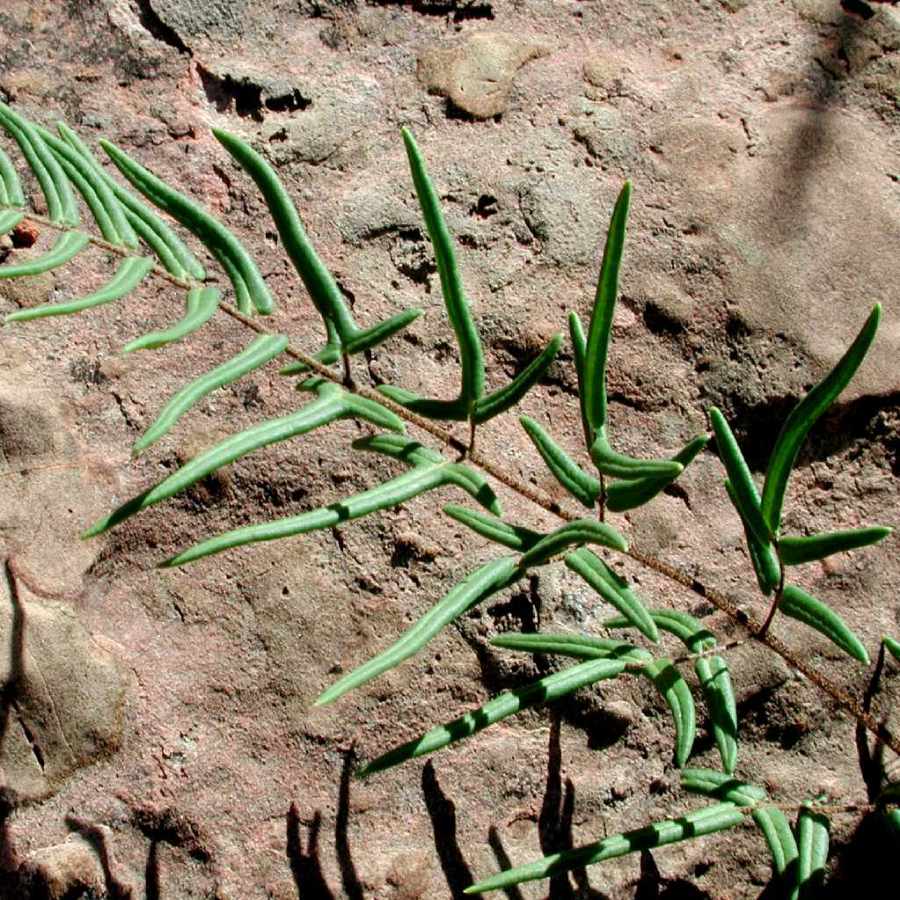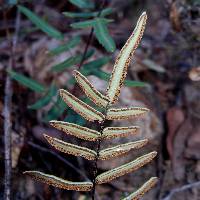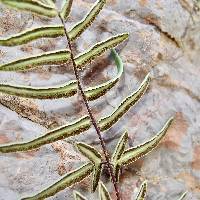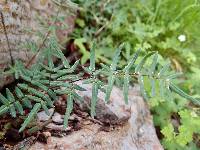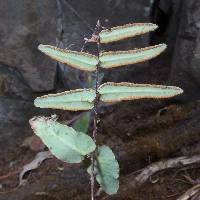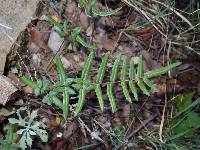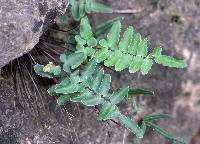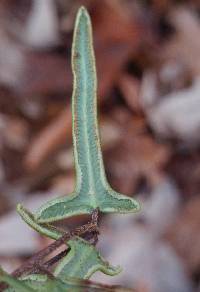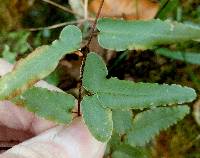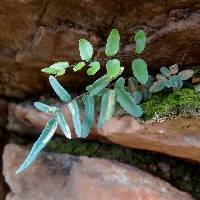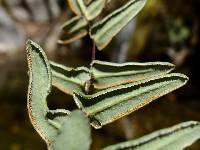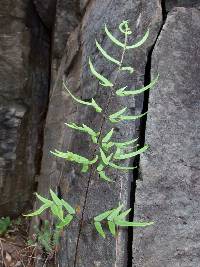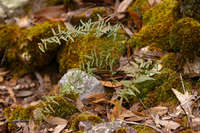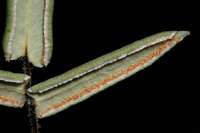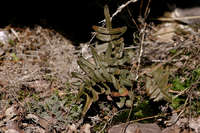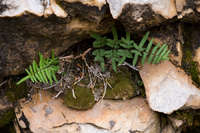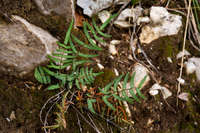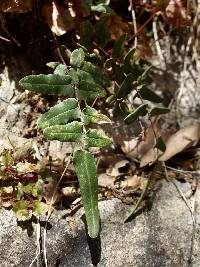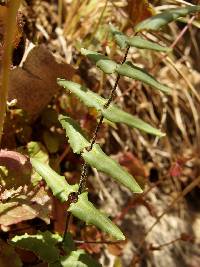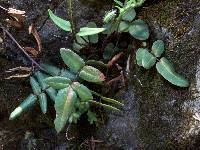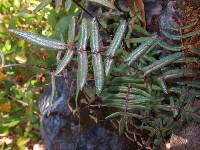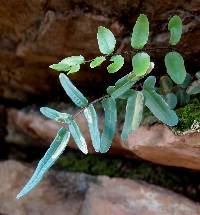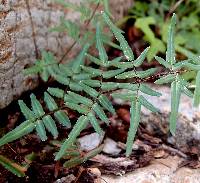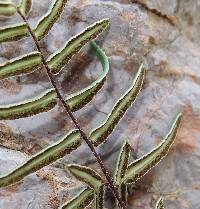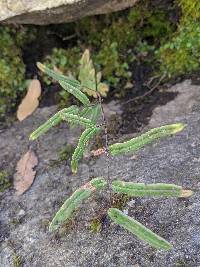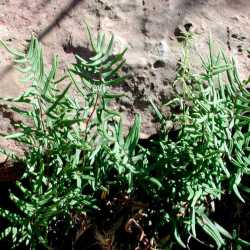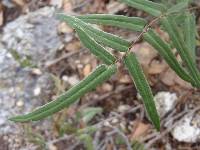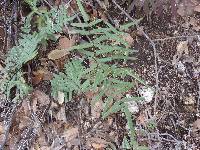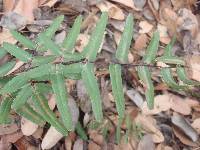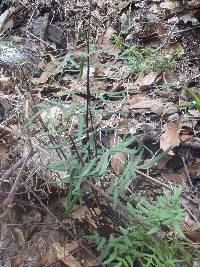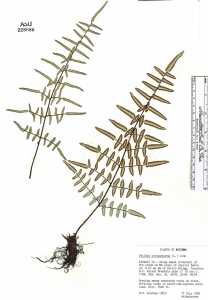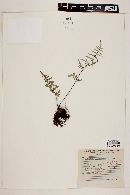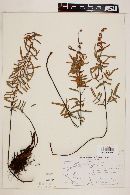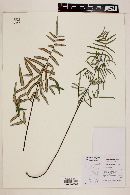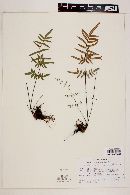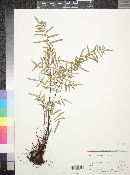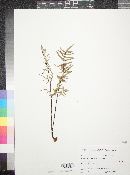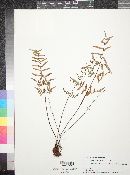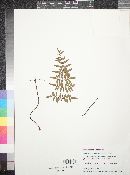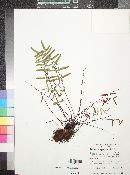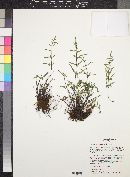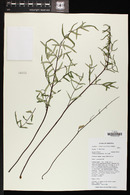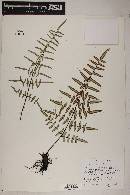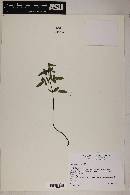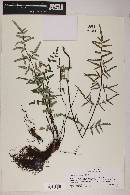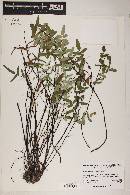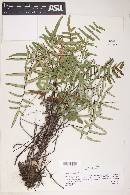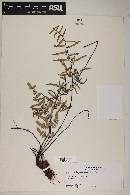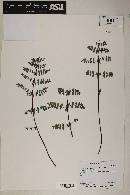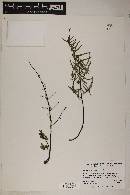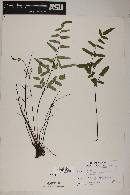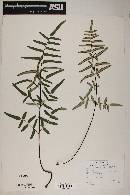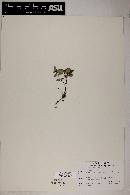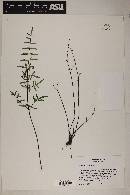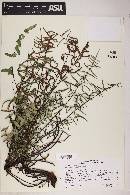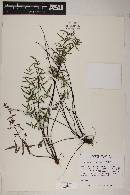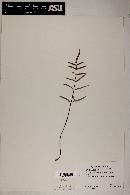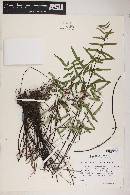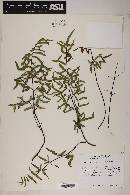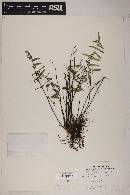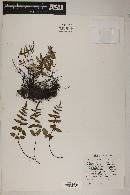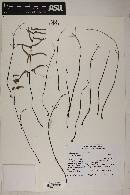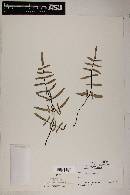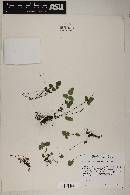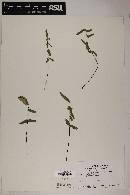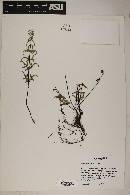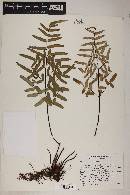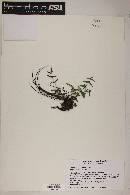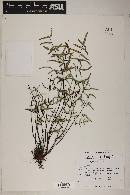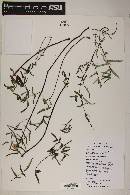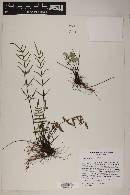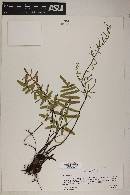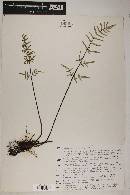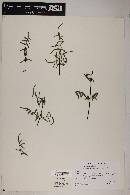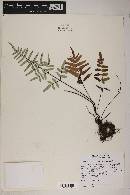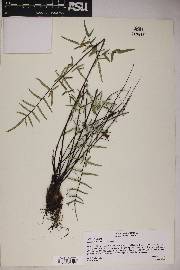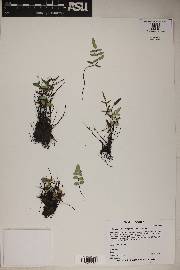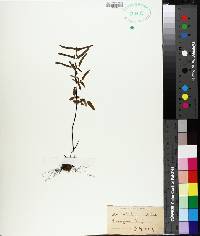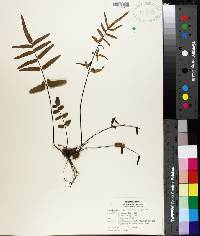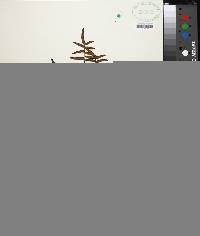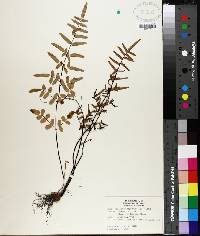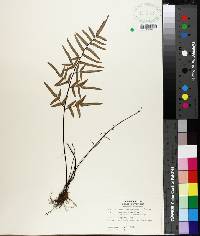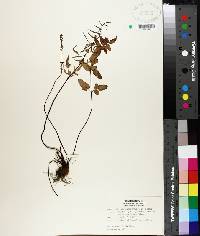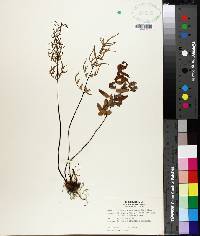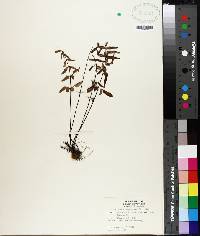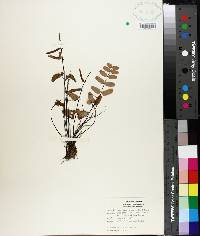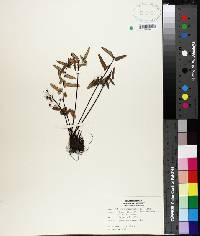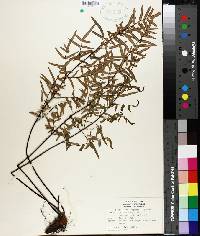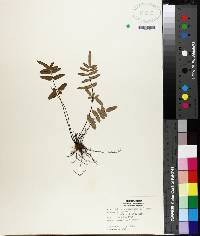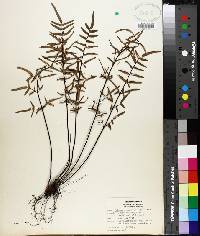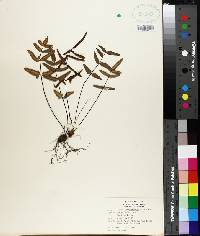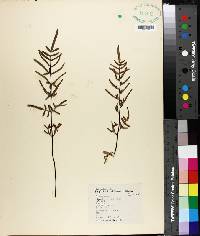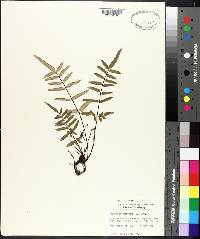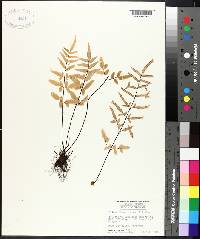Pellaea atropurpurea
|
|
|
|
Family: Pteridaceae
Purple-Stem Cliffbrake, more...Purple Cliff Brake, purple cliffbrake
[Allosorus atropurpureus (L.) Kunze, moreHemionitis atropurpurea (L.) Christenh.] |
Stems compact, ascending, stout, 5--10 mm diam.; scales uniformly reddish brown (or tan), linear-subulate, 0.1--0.3 mm wide, thin, margins entire to denticulate. Leaves somewhat dimorphic, sterile leaves shorter and less divided than fertile leaves, clustered on stems, 5--50 cm; croziers villous. Petiole reddish purple to nearly black, lustrous, rounded adaxially, without prominent articulation lines. Blade elongate-deltate, usually 2-pinnate proximally, 2--18 cm wide; rachis reddish purple throughout, straight, rounded adaxially, densely pubescent adaxially with short, curly, appressed hairs. Pinnae perpendicular to rachis or ascending, not decurrent on rachis, usually with 3--15 ultimate segments; costae straight, 10--100 mm, often longer than ultimate segments. Ultimate segments linear-oblong, 10--75 mm, leathery, sparsely villous abaxially near midrib; margins weakly recurved to plane on fertile segments, usually covering less than 1/2 abaxial surface, borders whitish, crenulate; apex obtuse to slightly mucronate. Veins of ultimate segments obscure. Sporangia long-stalked, containing 32 spores, not intermixed with farina-producing glands. n = 2 n = 87, apogamous. Sporulating summer--fall. Calcareous cliffs and rocky slopes, usually on limestone; 100--2500 m; Ont., Que.; Ala., Ariz., Ark., Colo., Conn., D.C., Fla., Ga., Ill., Ind., Iowa, Kans., Ky., La., Md., Mass., Mich., Minn., Miss., Mo., Nebr., Nev., N.J., N.Mex., N.Y., N.C., Ohio, Okla., Pa., R.I., S.C., S.Dak., Tenn., Tex., Utah, Vt., Va., W.Va., Wis., Wyo.; Mexico; Central America in Guatemala. Contrary to D. B. Lellinger's (1985) hypothesis, isozyme data indicate that neither Pellaea glabella nor P . ternifolia was involved in the origin of this apogamous triploid. Instead, it appears that P . atropurpurea is an autopolyploid derivative of a single diploid taxon that has not yet been located. A thorough survey of spore number per sporangium in this species should be undertaken to determine whether the diploid progenitor is still extant. Collections from western Canada identified as P . atropurpurea actually represent P . gastonyi , an apogamous tetraploid produced by hybridization between P . atropurpurea and diploid populations of P . glabella . Pellaea atropurpurea has also hybridized with P . wrightiana ; the hybrid is a rare apogamous pentaploid known only from western Oklahoma. Pellaea lyngholmii is the apogamous tetraploid hybrid between P . atropurpurea and P . truncata . Pellaea atropurpurea is distinguished from all these hybrids by having rachises that are densely pubescent adaxially, larger ultimate segments, and spores averaging less than 62 µm in diameter.
General: Dimorphic leaves, sterile shorter and less divided than fertile, clustered on stems 5-50 cm, villous croziers, from compact stems, ascending, stout, 5-10 mm in diameter, with scales rusty brown, linear-subulate, 0.1-0.3 mm wide, thing, margins entire to d Leaves: On reddish purple petiole to nearly black, rounded above; blade elongate-deltate, 2-pinnate below, 2-18 cm wide, reddish purple rachis throughout, rounded above, densely pubescent above with short, curly and appressed hairs; pinnae perpendicular to rachis, with 3-15 ultimate segments; costae straight, 10-100 mm, ultimate segments linear-oblong, 10-75 mm, leathery, sparsely villous below near midrib, weakly recurved margins on fertile segments, covering half under surface, whitish borders, crenulate, apex obtuse to slightly mucronate. Sporangia: Long stalked with 32 spores, found under the false indusium below the recurved margins. Ecology: Found commonly on limestone substrates on cliffs and in rocky spaces from 3,500-7,000 ft (1067-2134 m); sporulates summer-fall. Notes: The densely pubescent upper surfaces of the rachis, along with the larger ultimate segments help to distinguish this species. Ethnobotany: Infusion of roots taken to thin the blood, flush the kidneys, and taken as a preventative against sunstroke. Etymology: Pellaea is from the Greek pellaios, dark, alluding to the stalk, while atropurpurea means dark purple. Sources: FNA 1993, Dittman et al. 1954, Kearney and Peebles 1969 FNA 1993, Dittman et al. 1954, Kearney and Peebles 1969 Common Name: purple cliffbrake General: Dimorphic leaves, sterile shorter and less divided than fertile, clustered on stems 5-50 cm, villous croziers, from compact stems, ascending, stout, 5-10 mm in diameter, with scales rusty brown, linear-subulate, 0.1-0.3 mm wide, thing, margins entire to denticulate. Leaves: On reddish purple petiole to nearly black, rounded above; blade elongate-deltate, 2-pinnate below, 2-18 cm wide, reddish purple rachis throughout, rounded above, densely pubescent above with short, curly and appressed hairs; pinnae perpendicular to rachis, with 3-15 ultimate segments; costae straight, 10-100 mm, ultimate segments linear-oblong, 10-75 mm, leathery, sparsely villous below near midrib, weakly recurved margins on fertile segments, covering half under surface, whitish borders, crenulate, apex obtuse to slightly mucronate. Sporangia: Long stalked with 32 spores, found under the false indusium below the recurved margins. Ecology: Found commonly on limestone substrates on cliffs and in rocky spaces from 3,500-7,000 ft (1067-2134 m); sporulates summer-fall. Notes: Distinguished by the dark, shiny petioles and rachises; stem scales (at the base of plant) uniformly reddish or brown and not bicolored with a central stripe; lobes of blades linear and elongated to 30 mm (in most Pellea these are much shorter) and the upper surface of rachis covered with short curly hairs. Ethnobotany: Infusion of roots taken to thin the blood, flush the kidneys, and taken as a preventative against sunstroke. Etymology: Pellaea is from the Greek pellaios, dark, alluding to the stalk, while atropurpurea means dark purple. Synonyms: None Editor: SBuckley 2010, FSCoburn 2015 Rhizome-scales 3-6 mm, appressed, matted, dull tawny or rusty, the young tips tan and entangled; lvs slightly dimorphic, stiffly erect, mostly 20-40 cm; petiole shorter than the blade, purplish-brown, obviously hairy (as also the rachis) especially on the upper side; pinnae 5-11 pairs, petiolulate, the sterile ones ovate to broadly oblong, the basal mostly at least twice as long as the upper and with 3-15 segments, the ultimate segments mostly 1-7.5 נ0.5-1 cm; fertile segments narrower than the sterile, linear-oblong, acute, mucronate, the irregularly revolute margin opening and commonly leaving many sporangia exposed, eventually becoming flat; 2n=87, an apogamous triploid with 32 spores per sporangium. Calcareous rocks and open woods; s. Que., Vt., and R.I. to Minn. and Wyo., s. to Fla., Ariz., and Mex.; disjunct in Sask., Alta., and B.C. Thought to have originated by hybridization of P. glabella with another undetermined sp. Gleason, Henry A. & Cronquist, Arthur J. 1991. Manual of vascular plants of northeastern United States and adjacent Canada. lxxv + 910 pp. ©The New York Botanical Garden. All rights reserved. Used by permission. From Flora of Indiana (1940) by Charles C. Deam Infrequent to very local in shallow soil on calcareous rocks. These rocks usually are the perpendicular cliffs and ledges along streams but are often small or large detached fragments at the base of cliffs. Sometimes it is found in the seams of stratified rock outcrops only a few feet high. It grows in both shade and sun, preferring shade of medium density. My Wabash County specimen was found about a mile southeast of Lagro on Hanging Rock, which is 84 feet high. It is probably extinct there now since that place has become a picnic ground. …… Indiana Coefficient of Conservatism: C = 10 Wetland Indicator Status: N/A |
|
|
|

